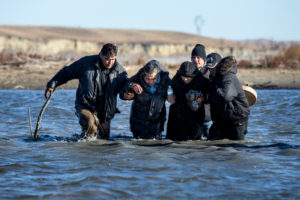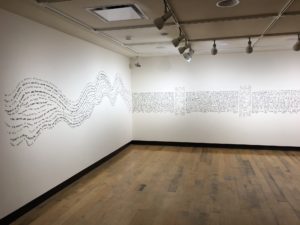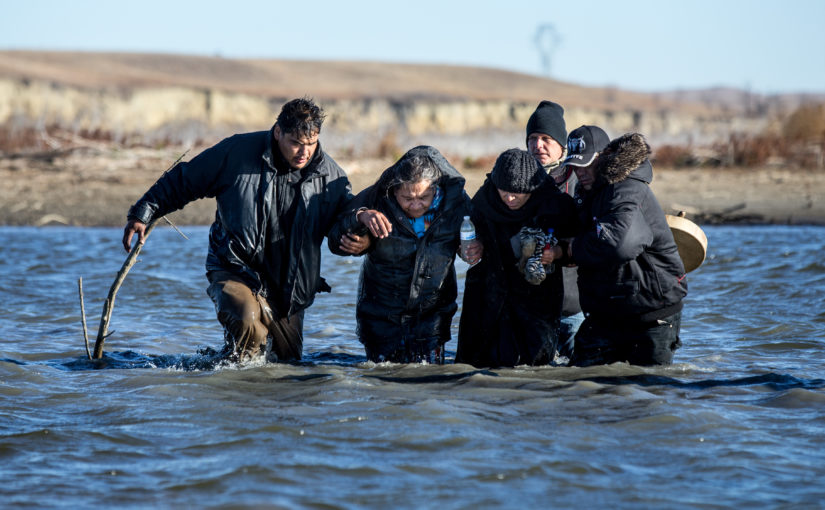
Activist and photographer Louis Fisher captured the social aspect of the protests and the anti-DAPL movement, adding subjectivity to his portion of the “Standing Rock” exhibit.
In September 2016, protestors began occupying Standing Rock Reservation to prevent the construction of the Dakota Access Pipeline.
A year later, the Memorial Union Gallery is bringing the conversation to the limelight once again.
In a three-part exhibition, the MU Gallery is examining health, wellness and the aftermath of the Standing Rock protests through photography, quotations and a traveling exhibit.
The first exhibition is “Native Voices,” a traveling exhibition that was brought to the gallery via NDSU Libraries. It examines the differing attitudes toward health and wellness across cultures, combining informational posters with recordings of stories for a firsthand glimpse into cultural understanding of the topics.
“(NDSU Libraries) wanted to bring (‘Native Voices’) for that time period, and they asked whether or not we would have an opportunity to exhibit it,” MU Gallery coordinator and curator Anthony Faris said. “So we created a corresponding exhibition to respond to the exhibition they were bringing in.”
These two corresponding exhibits include “Standing Rock,” an exhibit from photographers Louis Fisher and Robert Tsong-Taatarii, and a wall that has handwritten quotes from different newspaper sources, documentaries and oral stories of the Standing Rock protests. The quotes are formed in the shape of the Missouri River, which cuts through Standing Rock Reservation, and a pipeline.
“A member of multicultural came up, and we were talking about how we were going to fill this up with quotes and she was talking about the space, the architecture and how you would navigate it,” Faris explained. “That sort of offered up the opportunity of thinking about, ‘What if something visually happened with the quotes?’ So that they weren’t just something that was flat on the wall that you just would read, but that they actually became indicative of the thing they were talking about.”
This offers viewers to look at the facts of the situation — the written evidence of the protests — against images of the people involved.
“I think the facts are important, but I think it’s also very interesting and very necessary to think about the human element,” Faris said.
Louis Fisher is a photographer and an advocate, who focused more on the social impact of the protests Faris explained. Robert Tsong-Taatarii is a photographer for the Star Tribune in Minneapolis, Minnesota, took a more objective approach to the conflict.
“This exhibition really intertwines the objective with the subjective,” Faris said.
He continued on by saying, “I think metaphorically, I would say that (the exhibit) has given an opportunity for a voice to be heard that may have already spoken. Ultimately, this is an echo of a movement or an issue that shouldn’t disappear from our conversations that we’re having right now. I

Part of the “Native Voices” and “Standing Rock” exhibit includes handwritten quotes from newspapers, documentaries and oral histories on the Standing Rock protests.
think that’s very real with that, when you’re listening to people’s voices or whether or not you’re taking note about how people are speaking about the pipeline and the protestors or whether or not you’re looking at situations that are ultimately very real and very human, sometimes incredibly callous and violent.”
While “Native Voices” specifically focuses on health and wellness in indigenous cultures, Faris believes water is directly tied to that idea.
“The story that they’re telling is health and wellness and how it’s sort of dependent on culture and place,” he said about “Native Voices.” “So then we were thinking, well, we’re really talking about, there’s a huge issue going on with the pipeline and with culture and place. So, how can we link that story of health, which is specific to our region, with people being concerned about the health of their water.”
In addition to the art on the walls, the gallery will be screening two episodes from “Rise,” a series of episodes on Viceland that explore how indigenous communities fight colonization today, on Thursday, Oct. 26 at 7 p.m. in Century Theater.
The two episodes the gallery will be showing are both related to Standing Rock:
“One of them is before the protest, and one of them is during the protest,” Faris said. “I think that works really well with the exhibition. Even though we’re showing what happened, we’re living in the aftermath of it.”
The “Native Voices” and “Standing Rock” exhibitions correspond with November, which is Native American Heritage Month.
For more information on the Memorial Union Gallery, visit their Facebook page or their website.
